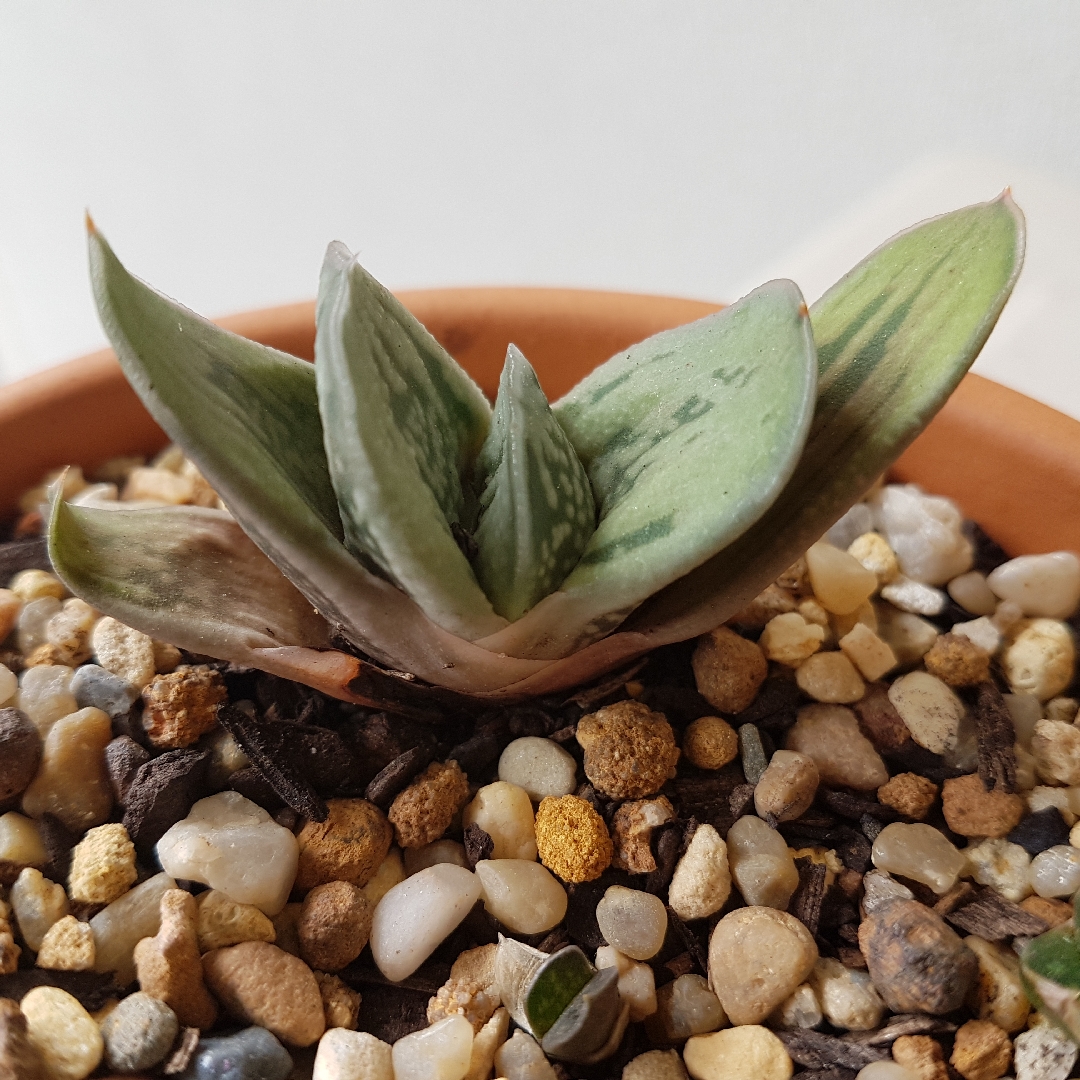
Gasteria Obtusa Salm-Dyck Haw
Gasteria 'Obtusa Salm-Dyck Haw'
Original:Description: Gasteria obtusa (synonym of Gasteria nitida var. nitida) is a dwarf distichous plant with dark green, spotted leaves. It is a popular species introduced in cultivation about in 1820.Stem: Acaulescent or very short and stocky (2-5 cm long).Roots: Thick, fusiform and succulent, with little branching, and endowed with the ability to contract, physically pulling the plant down into the ground during dry weather.Rosettes: Distichous (growing in two planes only), grading into the rosulate form as plants ages, more or less pressed into the soil, rarely more than 20 cm in overall length in the wild, but quite variable in size and shape especially in cultivation. Old specimens cluster naturally with new plants around the original. It is slow growing. Mature and juvenile Gasteria obtusa often differ markedly. Leaves: 12-18 tongue-like, 5-15 (rarely more) cm long, up to 3,5 cm broad and 1,2 cm thick, inner ascending, outer spreading, concave on the upper face, obliquely keeled down the back, dark glossy-green that can take maroon-red colouring in full sun, with prominent immersed paler spots in transverse rows, the leaf ends are obtuse (hence the species name)and mucronate. Margin cartilaginous entire or minutely toothed. Variegated forms with heavy bands of whitish-yellow markings on the green leaves are also known in cultivation. New:Gasterias are recognisable from their thick, hard, succulent "tongue-shaped" leaves. Gasteria are grown in well-drained, sandy soils in light shade. They can be propagated by off-sets and cuttings. They are also commonly propagated by seed. Germination usually occurs within 8 days but may take as long as one month, depending on the species.
-
Partial shade
-
Very little water
-
A little frost hardy: 32F (0°C)
-
Light and free draining
Common name
Gasteria 'Obtusa Salm-Dyck Haw'
Latin name
Gasteria Obtusa Salm-Dyck Haw
type
Succulent
family
Asphodelaceae
ph
5.0 - 7.0 Acid - Neutral
Plant & bloom calendar
-
Best time to plant
full grown dimensions
 0.30 M
0.30 M
0.30 M
0.30 M
Gasteria Obtusa Salm-Dyck Haw
Original:Description: Gasteria obtusa (synonym of Gasteria nitida var. nitida) is a dwarf distichous plant with dark green, spotted leaves. It is a popular species introduced in cultivation about in 1820.Stem: Acaulescent or very short and stocky (2-5 cm long).Roots: Thick, fusiform and succulent, with little branching, and endowed with the ability to contract, physically pulling the plant down into the ground during dry weather.Rosettes: Distichous (growing in two planes only), grading into the rosulate form as plants ages, more or less pressed into the soil, rarely more than 20 cm in overall length in the wild, but quite variable in size and shape especially in cultivation. Old specimens cluster naturally with new plants around the original. It is slow growing. Mature and juvenile Gasteria obtusa often differ markedly. Leaves: 12-18 tongue-like, 5-15 (rarely more) cm long, up to 3,5 cm broad and 1,2 cm thick, inner ascending, outer spreading, concave on the upper face, obliquely keeled down the back, dark glossy-green that can take maroon-red colouring in full sun, with prominent immersed paler spots in transverse rows, the leaf ends are obtuse (hence the species name)and mucronate. Margin cartilaginous entire or minutely toothed. Variegated forms with heavy bands of whitish-yellow markings on the green leaves are also known in cultivation. New:Gasterias are recognisable from their thick, hard, succulent "tongue-shaped" leaves. Gasteria are grown in well-drained, sandy soils in light shade. They can be propagated by off-sets and cuttings. They are also commonly propagated by seed. Germination usually occurs within 8 days but may take as long as one month, depending on the species.
Propagation
From Early Spring TO Late Winter
To propagate by leaf cuttings, remove a leaf and let it lie for about one month (e.g. in a cool window sill), giving the wound time to heal. Then lay the leaf on its side with the basal part buried in the soil. This leaf should root within a month or two, and small plants will form at the leaf base. Young plants can be harvested the following season. They can also grown from seed. Seed should be sown during summer in sandy well drained soil and preferably protected from full sun. The seedlings are slow growing and can be planted out in small containers when they are large enough to handle. The soil should preferably be enriched with compost. They react very well to a liquid organic fertilizer.
Planting young plants
From Early Spring TO Late Summer
Gasteria need light shade to shade, but will take full sun part of the day. (with some sun exposure the leaf develops a nice reddish tint and remain compact) They are tolerant of a wide range of soils and habitats, but prefer a very porous potting mix to increase drainage.








